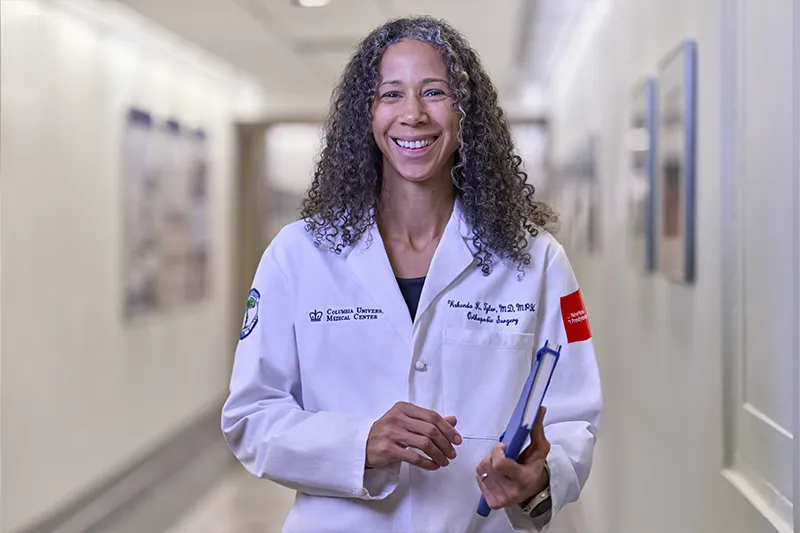Dr. Wakenda Tyler is used to forging her own path. She was the first in her family to graduate from college. She went on to medical school and entered orthopedic surgery, one of the most male-dominated specialties. And she chose to subspecialize in orthopedic oncology, where she treats rare sarcomas that make up just 1 percent of all adult cancer diagnoses.
None of this ever deterred the Pennsylvania native, not even when she felt the extent of the diversity gaps in orthopedic surgery. “It wasn’t until after I entered the field that I realized there weren’t a lot of people who looked like me, but I didn’t let that discourage me,” says Dr. Tyler, who is Chief of the Orthopedic Oncology Service at NewYork-Presbyterian/Columbia. “In a way, that gave me a bit of an edge because I never paused to think about whether I was going to fit in. I just knew I liked it, it was fun, and I was doing well.”
In fact, it only fueled a desire to explore disparities in orthopedics. In 2020, Dr. Tyler became the Vice Chair for Diversity, Equity, and Inclusion in the Department of Orthopedic Surgery, with a broad mission of tackling inequities within the specialty but also in access to patient care. “I’ve always had an interest in underserved communities because as a Black American, I am from one,” she says. “Orthopedics has not traditionally been a field that has focused on disparities, but I’m really proud that our department has been one of the leaders in that space.”
NYP Advances spoke to Dr. Tyler about her clinical work and research, and how she hopes it’ll make an impact on bringing orthopedic care to everyone.
How did you choose orthopedic oncology as your specialty?
I had a personal reason for becoming a cancer doctor. I had a close family friend who was diagnosed at a young age with breast cancer and ultimately succumbed to it. I saw her suffering and wanted take on that type of care. Then I met a bone pathologist in medical school who had also trained as an orthopedic surgeon, and he became a mentor of mine. He encouraged me to look into orthopedics, and I found the intricacy of bone pathology and biology intellectually stimulating. When I found out I could do orthopedic oncology, it was a no-brainer. I found my calling.
What clinical advancements do you believe have had the biggest impact on your field?
The nice thing about orthopedic oncology is how integrated we are with our medical oncology partners, so what impacts them impacts us. In the last few years, there have been advancements in the targeted immunotherapies that we can offer patients that give them a better chance at living longer. Patients who once had a one-year life expectancy because their cancer was metastatic might now have a 15- or 20-year life expectancy. That affects how we treat those patients. I can’t use an orthopedic implant that only lasts one to two years; it has to last decades.
On the orthopedic surgery side, I would say the biggest advances have been in the realm of implants and technology. For example, 20 years ago, if you wanted to replace a knee or hip you had maybe three size options. If the anatomy didn’t fit, you would jerry-rig it to make it work. Now if you have a patient with unusual anatomy, you can get a 3D-printed custom implant made quickly. There are 3D-cutting guides so precise that even when we use allografts, they fit perfectly. Growing prostheses for kids have also gotten better. We used to have to perform surgery to lengthen a patient, but now we can lengthen limbs by a few millimeters using a magnet.
And one of the big revolutions happening right now in orthopedic oncology is that innovation in deformity correction and bone regeneration is spilling over into our field. As a result, we’re doing more creative limb-sparing surgeries that regrow bone in patients, which we would not have been able to do 20 to 25 years ago.
Is there something missing in the field that you hope to address through your work?
One area where we still fall short is in understanding some metastatic cancers. For instance, renal cell carcinoma is a carcinoma that metastasizes to the bone. When it gets to the bone, it often doesn’t respond well to treatment, even if other areas of the body are responding to chemotherapy. I’ve done research in the past exploring proteins involved in the spread of renal cell carcinoma and hope to continue to do more in the future.
You’ve also researched health equity issues in orthopedic oncology. How have you seen patients impacted by disparities, and how do you hope your findings will translate to better patient care?
Earlier research I’ve done looked at national databases of sarcoma patients and how their insurance status affected their outcomes. Those who were uninsured or underinsured had lower survival rates and higher rates of amputation. Now I’m looking at outcomes for sarcoma patients who don’t speak English as a primary language. Some questions we’re trying to answer include: Did they have the same surgical outcome as someone whose primary language is English? Did they have an amputation or a limb-sparing surgery? What was their mortality and morbidity? Language-barrier research has been done on higher-volume cancers like breast cancer and prostate cancer, but it’s newer for sarcoma patients. I believe we’ll also see disparities in our patient population.
The reason why I wanted to look at this scientifically is because in my clinical experience, I’ve seen poorer long-term outcomes in patients for whom English isn’t a primary language.





